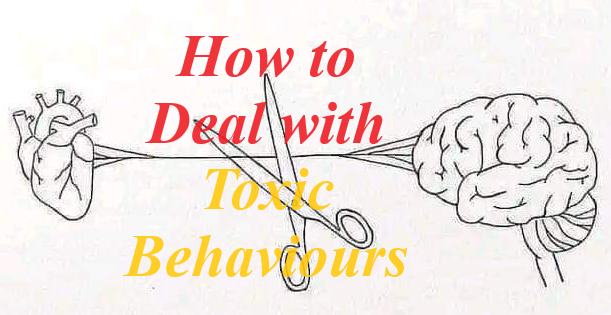Understanding and Dealing with Toxic Behaviours in Our Everyday Life

Understanding and Dealing with Toxic Behaviours in Our Everyday Life
Sensory inputs such as the sights of people, places, and things; smells, fragrances, and aromas; or sounds, music, and songs can govern how we feel.
These are all things that can transport us to another part of the world as they connect with the strong memories that are associated with them.
Some of those memories are very pleasing and can thrill our minds, while others are not, and can leave our minds disturbed.
A severe form of this can be post-traumatic stress disorder (PTSD), which is caused by stressful, frightening, or distressing events.
Flashbacks and nightmares are common ways in which people with PTSD relive traumatic events.
They may even be bombarded with feelings of isolation, irritability, and guilt because of a serious episode in their lives.
These symptoms are often severe and persistent enough to have a substantial impact on the person’s day-to-day life.
Isn’t it ironic that when we are born, people love us and when we die, people love us, but in between, we have to manage somehow?
I hate labelling people as toxic.
- No one is fully toxic or a ‘supervillain’ despite what we see in the movies.
- However, people can get caught demonstrating toxic behaviour in their actions, their energy, their words, their dealings, and their insensitivity, which can hurt us.
- We all know of someone who continuously demonstrates toxic behaviour.
- They may make us feel worse after we meet them than we did before.
- It might be someone at work, a close friend or even someone in your immediate family.
- ‘Being toxic’ is a common phrase and is thrown around in day-to-day language, but it is hard to define scientifically.
- When it comes to other people’s behaviours, we should start labelling behaviours that are problematic.
- In many cases, it is easier to spot these behaviours in other people than it is within ourselves.
Some toxic behaviour traits are;
- self-absorption or self-centredness
- manipulation and other emotional abuse
- dishonesty and deceit
- difficulty in offering compassion to others
- a tendency to create drama or conflict
These might sound common, but it is important to note that it is repeatedly demonstrating these behaviour traits that can make someone toxic.
We can also classify toxicity by why it is demonstrated.
Types of toxic patterns
Everyone goes through difficulties in their life.
Our emotions move up and down like the waves in the sea.
- It should be normalized that no one is perfect, and we all struggle in some areas of our lives.
- We may get into a bad mood after being stuck in traffic after work, we may be irritated by how our partner leaves their laundry all over the house, and we may even go through misunderstandings with our friends over petty issues.
- Whatever the reason, we may also end up exhibiting toxic behaviours because of a given situation.
- We take note of such behavioural traits because of a situation to make sure it does not become a repetitive pattern.
- We have to assess whether the incident deserves our empathy or our correction.
When we know that someone’s toxic behaviour is not situational, it could be a habitual toxic trait.
- At first, we should give them the benefit of the doubt as their habit may be unintentional.
- Although the responsibility for our actions is our own, we are a product of our environment.
- Therefore, the way we develop habits may be unconscious.
- If a person is toxic because of this, they also may need a dose of empathy from someone to get out of this behaviour pattern.
- They need help.
- We must intervene promptly but sensitively, in a way that they do not feel embarrassed and we do not become the object of their toxicity.
The final type of toxic person does so with intention.
- They consciously behave in a certain way that may hurt us.
- As stated above, they may be self-centered, manipulative or dishonest in their behaviour, purposely.
- With this type of person, we must evaluate their value in our life and deal with them accordingly.
- Are they a close relative who is hard to ‘cut off?’
- Are they a work colleague integral to our business?
- Are they someone that we do not need to be close to?
Why this is important is that we need to make a tough decision:
- Do we approach them about their intentionally toxic behaviour, or do we move on with our lives without them?
- This may seem harsh, but protecting our mental well-being is one of the most important things we can do.
- As much as we want to, we cannot be friends with a predatory wild animal.
- It is its nature to attack us if we get close, so we have to just respect them from a distance.
- I have been attacked by such ‘toxic animals’ in the past and have learnt the lesson that we cannot be friends with them, however much we want to.
- It is imperative that, when categorizing people who carry toxic behavioural traits into these groups, we do so in a mood of not judging them, but protecting our mental health and trying to help them.
How to deal with toxic behaviour
- To an extent, we all have some toxicity within us, but it may just be situational.
- Recognizing that is healthy.
- However, when we are getting to the point of seeing these characteristics repeatedly and it is affecting our mental health, it may be time to open up to someone who we trust about this issue.
- Otherwise, we will be left feeling angry, annoyed, frustrated, victimized, mentally drained, guilty, spiteful or wanting revenge.
- These emotions are not good.
- These emotions need to be dealt with effectively.
- If not, we leave ourselves vulnerable to mental health problems in the future.
- This is not an exhaustive list, but these are some tools to help us deal with toxic people, depending on why they are toxic.
Set your boundaries
- It is our choice to control the quality and quantity of our interactions with people.
- With every person in our life, we have to know where to set our boundaries.
- How close are we to this person?
- How much do we share with them?
- How much time do we want to spend with them?
- These are three important questions to answer that are dependent on our personal goals and aspirations.
- We do not need to calculate and create an Excel sheet about this, but we should take stock of our relationships and boundaries with people.
- When we know that someone is toxic, we have to limit our interactions with them by doing the needful.
- Strong boundaries mean we can choose who can cross over into our lives, who has limited access and who is restricted.
Take charge of your emotions
- The hardest word to speak out, from the English dictionary, is ‘no’.
- The human condition is such that we want to help other people and please them.
- Whether it is due to the need for social acceptance or out of genuine selflessness, it is difficult for us to say no.
- However, for hundreds of years now, the world has been transitioning from ‘survive to thrive’, which means that for self-actualization and spiritual growth, we need to learn how to refuse.
- It is commonplace for people to agree to things to avoid.
- Even in a social context, learning to say no is important, especially if it means you are exposed to or get involved with toxic behaviour.
- We don’t have to attend all the social drama we are invited to.
- In other words, just because some people are fuelled by drama, it does not mean we have to attend the performance
-
To say no, we have to take charge of our emotions and reclaim our priorities.
- There will always be something in our lives that will make us feel compelled to say yes, but if it leaves us miserable and repeatedly strains our mental well-being, then it is not worth it.
- We have to step out of the passenger seat and learn to get into the driver’s seat for our own lives, which means taking responsibility and accountability for our actions.
-
The way we deal with toxicity depends on why the person is being toxic.
- If it is situational and within our capacity to overlook the person’s mishaps, we can let it go.
- However, if their toxicity is habitual or intentional, it must be challenged and communicated.
- We have to say no in order not to be treated like a doormat and thereby protect our mental health.
- At the same time, we must also be comfortable enough to seek help from others, learn the art of saying no, and know how to bring up a potential argumentative point with someone sensitively.
- I always ask for help from my close friends when I have to have a difficult conversation so that I can get a better picture of the situation.
- This is especially important when such toxic behaviour comes from people whom we are always surrounded by and cannot avoid being with.
A deeper aspect of dealing with toxicity is ‘vibrating higher’.
- The best compliment we can give someone is, ‘You have such great energy!’
- Beyond what they say, their accomplishments or how they look, this is a great compliment as it suggests that we appreciate them as a whole.
- The energy at which they vibrate is attractive.
- According to ancient spiritual texts, we all carry a certain energy:
- We are both transmitting and receiving antennas.
- An easy way to understand this is the difference in feeling we experience when going into a hospital, a nightclub or a temple.
- Although architecture definitely plays a role, as even matter in different combinations carries a certain energy, these vibes are not just created by bricks and mortar.
- They are created by the people there who act as transmitting antennas.
- Just as we can transmit energy, we can also receive energy from others.
- We can get affected by people’s toxic energy if we are around them too long.
- However, if we can learn to change our frequency, to vibrate higher than them, then we can be less affected.
- Just as eagles that fly above the clouds are not affected by the storm, if we can learn to vibrate higher, we can definitely soar.
But how do we vibrate higher?
-
Focus on your priorities
When we focus on our priorities, we don’t have the time to see all the drama around us.
The fact is, anywhere we go, we’re going to find toxic people.
The grass is not always greener on the other side, but where we water it.
We should do what we can to positively change things around us and improve the culture.
But when we know we’ve done our best, we should shift our focus to the glass of water our priorities, our growth, our excellence, and then we won’t be as affected by the negativity around us.
If it is absolutely beyond our capacity to handle, we may actually need a change, knowing well that the new job or the new situation will bring fresh complexities along with it as well.’
-
Increase your inner strength
To vibrate at a higher frequency, you need to connect with a higher energy internally.
Some people practice mantra meditation daily to help them connect to the Divine.
You may have another spiritual practice such as praying at a certain time of the day, reading spiritual texts, singing hymns and songs or other forms of meditation.
The important thing is finding what works for you and being consistent in your practice.
Just as going consistently to the gym is beneficial to our health, consistent spiritual practices can help us improve our inner strength, thus helping us deal with toxic energy.
-
Increase your association with positive people
Every action we perform is our choice.
Although we may not be able to limit our interactions with negative people in some situations, such as work or family events, and might have to do the needful, we can choose who we spend time with outside of that.
For instance, do you need to go to that work-related event if it does not serve your higher purpose?
Making choices and saying no is tough, but as we have discussed, they are imperative to our success.
We must increase our association with those who have a higher vibration.
A tip to know who carries a higher vibration is to observe their habits:
- how they speak,
- how they act,
- and what they do in their spare time.
We can understand someone’s demeanour by how they act in public, but we can understand their character by how they behave in private.
It is important to note that,
- There are two ways in which our ego can deceive us.
- One is by telling us, ‘I am the worst human being in the world’ and the other is by telling us, ‘I am the saviour of every human being in the world.’
- Both are damaging phrases to our lives.
- Although we need to learn how to say no and understand that we are not the saviour of other people’s lives, we can still do what we can to help those with toxic behaviour.
- We need to assess our capacity to help others.
- Not only does this help them but it helps us as we do not have to be exposed to their toxic tendencies.
Sometimes, people are unable to see what they are doing.
- They are looking through the microscope of their lives, unable to zoom out and see things from a different perspective.
- If spoken to sensitively and with love, they may see what we see and be driven to change.
- However, if we do this, we need to be prepared to do it multiple times as old habits die hard.
- We have to dig deep to forgive and remind people of their behaviour.
- This can be emotionally draining so we have to be ready to vibrate higher ourselves.
- Please note, that for those that are intentionally toxic, we must walk away and let them be.
- We cannot change such people and should not waste time trying to change them as they will drag us down with them.
If we do not know how to swim, let us not be a lifeguard.
Join us for more through this link
https://chat.whatsapp.com/Bt7QvtyljSPHCa7y17zLYP








